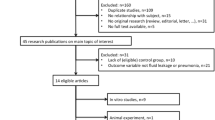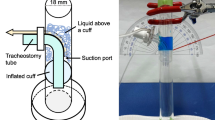Abstract
Objective
This study compared the recently introduced Microcuff endotracheal tube HVLP ICU featuring an ultrathin (7-µm) polyurethane cuff membrane with endotracheal tubes from different manufacturers regarding fluid leakage past the tube cuff.
Design
In vitro setup.
Measurements and results
The following endotracheal tubes (ID 7.5 mm) were compared: Mallinckrodt HiLo, Microcuff HVLP ICU, Portex Profile Soft Seal, Rüsch Super Safety Clear, and Sheridan CF. A vertical PVC trachea model (ID 20 mm) was intubated, and cuffs were inflated to 10, 15, 20, 25, 30, and 60 cmH2O. Colored water (5 ml) was added to the top of the cuff. The amount of leaked fluid past the tube cuff within 5, 10, and 60 min was recorded. Experiments were performed four times using two examples of each tube brand. Fluid leakage past tube cuffs occurred in all conventional endotracheal tubes at cuff pressures from 10 to 60 cmH2O. In the Microcuff tube cuff pressure fluid leakage was observed within 10 min only at 10 cmH2O. Results with the Microcuff tube were significantly better than all other tube brands at cuff pressures of 10–30 cmH2O.
Conclusions
Within the acceptable upper limit for tracheal cuff pressure (25–30 cmH2O) the Microcuff endotracheal tube was the only one of the tested tubes to prevent fluid leakage in our in vitro setup. In vivo studies are required to confirm these findings.

Similar content being viewed by others
References
Latto P (1997) The cuff. In: Latto IP, Vaughan RS (ed) Difficulties in tracheal intubation. Saunders, Philadelphia, pp 51–78
Seegobin RD, van Hasselt GL (1984) Endotracheal cuff pressure and tracheal mucosal blood flow: endoscopic study of effects of four large volume cuffs. BMJ 288:965–968
Asai T, Shingu K (2001) Leakage of fluid around high-volume, low-pressure cuffs. Anaesthesia 56:38–42
Young PJ, Blunt MC (1999) Improving the shape and compliance characteristics of a high-volume, low-pressure cuff improves tracheal seal. Br J Anaesth 83:887–889
Young PJ, Basson C, Hamilton D, Ridley SA (1999) Prevention of tracheal aspiration using the pressure-limited tracheal tube cuff. Anaesthesia 54:559–563
Young PJ, Ridley SA, Downward G (1998) Evaluation of a new design of tracheal tube cuff to prevent leakage of fluid to the lungs. Br J Anaesth 80:796–799
Young PJ, Rollinson M, Downward G, Henderson S (1997) Leakage of fluid past the tracheal tube cuff in a benchtop model. Br J Anaesth 78:557–562
Oikkonen M, Aromaa U (1997) Leakage of fluid around low-pressure tracheal tube cuffs. Anaesthesia 52:567–569
Reali-Forster C, Kolobow T, Giacomini M, Hayashi T, Horiba K, Ferrans V (1996) New ultrathin-walled endotracheal tube with a novel laryngeal seal design: long-term evaluation in sheep. Anesthesiology 84:162–172
Blunt MC, Young PJ, Patil A, Haddock A (2001) Gel lubrication of the tracheal tube cuff reduces pulmonary aspiration. Anesthesiology 95:377–381
Metha S, Myat HM (1984) The cross sectional shape and circumference of the human trachea. Ann R Coll Surg Engl 66:356–358
Inglis TJJ, Sproat LJ, Sherrat MJ, Hawkey PM, Gibson JS, Shah MV (1992) Gastroduodenal dysfunction as a cause of gastric bacterial overgrowth in patients undergoing mechanical ventilation of the lungs. Br J Anaesth 68:499–502
Ho AM, Aun CS, Karmakar MK (2002) The margin of safety associated with the use of cuffed paediatric tracheal tubes. Anaesthesia 57:173–175
James I (2001) Cuffed tubes in children. Paediatr Anaesth 11:259–263
Satishkumar S, Young P (2002) Tracheal cuff pressure–a survey of clinical practice. Br J Anaesth 88:456
Acknowledgements
We thank Mrs. Stephanie Müller, RNA, Department of Radiology, University Children's Hospital Zurich, for her most helpful assistance in performing CT of the investigated tracheal tube cuffs.
Author information
Authors and Affiliations
Corresponding author
Additional information
This study was supported by Microcuff GmbH, Weinheim, Germany, by providing the Microcuff tubes without charge. No financial support was obtained from the manufacturer for the study. Dr. Weiss and Dr. Gerber serve on the Medical Board of Microcuff GmbH for the development of a newly designed pediatric cuffed tracheal tube.
Rights and permissions
About this article
Cite this article
Dullenkopf, A., Gerber, A. & Weiss, M. Fluid leakage past tracheal tube cuffs: evaluation of the new Microcuff endotracheal tube. Intensive Care Med 29, 1849–1853 (2003). https://doi.org/10.1007/s00134-003-1933-6
Received:
Accepted:
Published:
Issue Date:
DOI: https://doi.org/10.1007/s00134-003-1933-6




